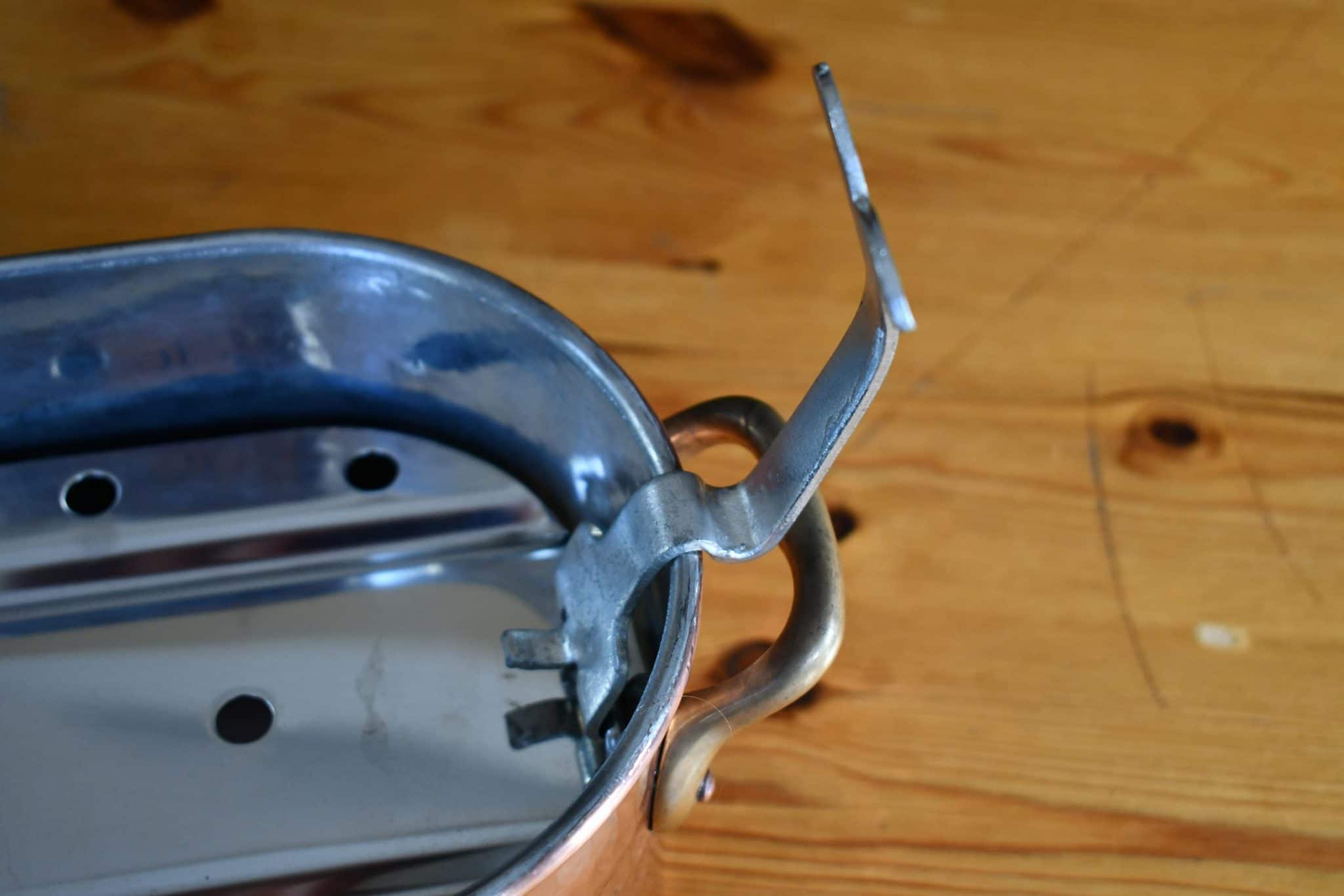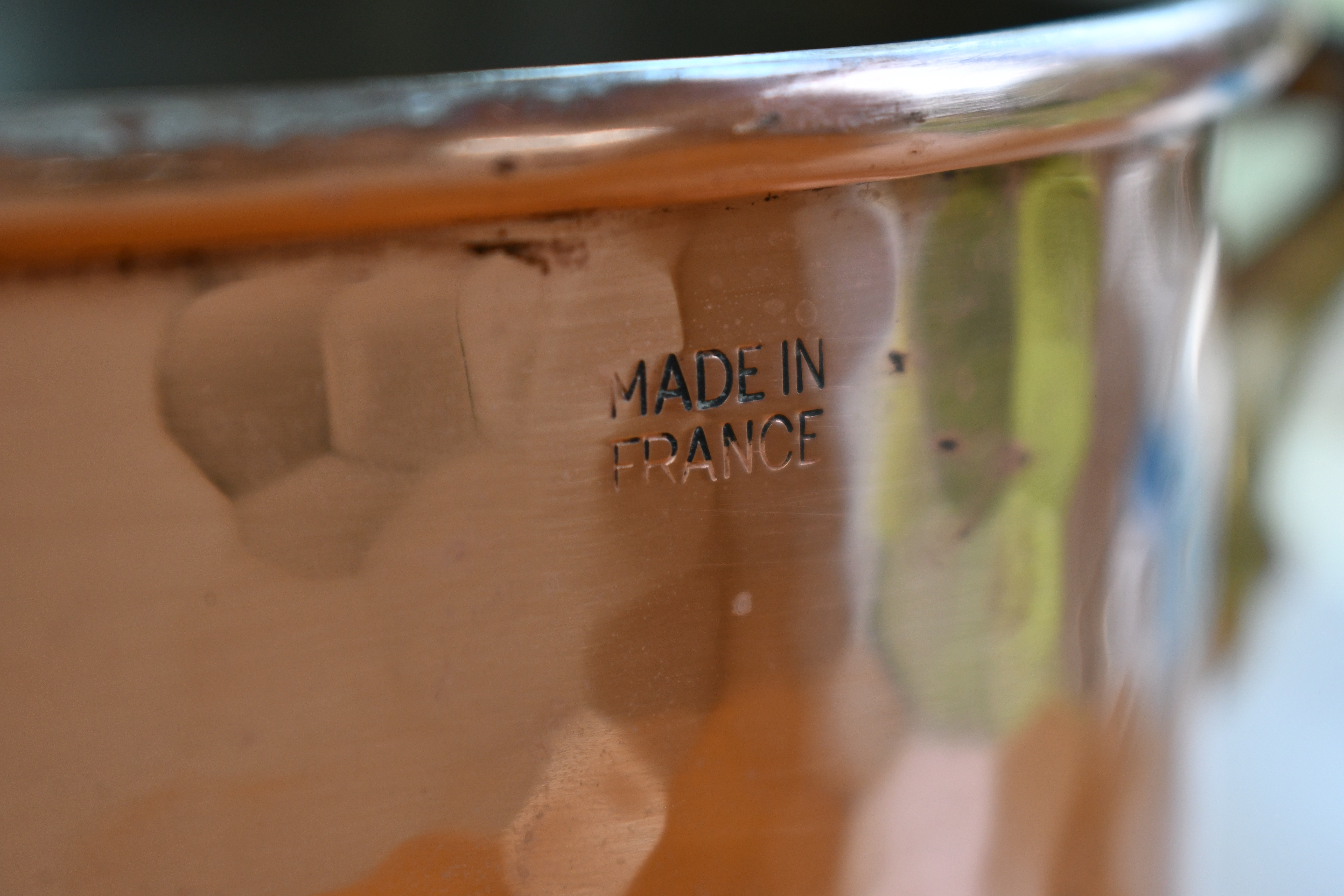This is one of the few single-purpose pans in the French batterie de cuisine.

- Type: Tin-lined truitière in hammered finish with brass handles fastened with two copper rivets and a steel lifter; domed lid with brass handle fastened with one copper rivet on each bracket
- French description: Truitière étamée et martelée avec poignées en laiton munies de deux rivets et plat-forme en acier; couvercle bombé avec poignée munie d’un rivet sur chaque côté
- Dimensions: 40cm long by 14cm wide by 10 cm tall (15.7 inches by 5.5 inches by 3.9 inches)
- Thickness: 1mm
- Weight: 1874g (4.1 lbs), body only; 2730g (6 lbs) with lid; lifter alone weighs 606g (1.3 lbs)
- Maker and age estimate: Mauviel; 1980s-2000s
- Source: Harestew
Just as the terrain of France is threaded with rivers and lakes, so also is the tapestry of French cuisine woven with recipes for cooking fish. Many of these recipes call for delicate flat filets to be poached or fried in one piece, which looks beautiful on the plate but can be tricky to accomplish. Enter the fish poaching pan, dedicated to the singular purpose of maintaining the fish in one piece during the cooking process.
The pan consists of two parts: a long narrow body with a well-fitting lid, and an interior lifter platform with vertical handles. The lifter platform fits neatly inside the pan and allows fish to be lowered into the poaching liquid and then raised again without disturbing it. This pan is an absolutely typical example, called a truitière for trout-sized fish up to about a foot long.

This pan is just 1mm thick and that’s pretty typical for a fish poacher, one of the few styles of pan where thicker copper walls don’t confer a cooking benefit. To poach fish (or chicken or whatever), you add a few inches of broth and aromatics to the pan, bring it to a good simmer, and then submerge the fish into it. This is a fairly straightforward task for a cooking vessel and it doesn’t really matter what material is used for it. Unlike a braise, there’s no browning or searing of the fish beforehand, so the pan doesn’t need to manage the heat of a sauté. And because the simmering liquid does all the work of spreading heat evenly around the fish, the walls of the pan don’t need to do the work of conducting heat.
But thin copper walls require some structural reinforcement, which is why this pan (and other poachers like it) has a rolled rim. Within that curled lip is tucked a ring of stronger metal — iron or steel — that holds the pan’s shape.

The lifter platform is made of steel and is quite cleverly designed with detachable handles.


The handles hook under loops on either end of the platform and have an interior prop that keeps them from falling inwards.


The handles enable the platform to be lowered neatly into the bottom of the pan, and the curvature of the fishtail end fits under the domed lid.


The handles are designed with a bend that enable them to catch on the lip of the pan and hold the platform suspended over it. This would be handy to drain the poached fish, or for loading and unloading the platform.


I believe this pan was made by Mauviel. While this pan does not carry a maker stamp, this version of the “Made in France” stamp is one I have seen on other pans with a Mauviel stamp.

While this pan was probably made sometime in the 1980s or 1990s, it’s pretty much identical to pans you can buy from Mauviel to this day. Like the daubière, turbotière, and poissonière, this truitière is an irregularly-shaped pan made by necessity with a mix of machine assembly and hand-finishing.
The body is made from sheets of copper that are welded together. This creates an almost imperceptible seam around the base of the pan, visible only as a slight distortion in the copper. I was unable to find the vertical seam up the side of the pan, a testament to Mauviel’s expertise.


The brackets on the steel lifter platform are also welded with visible dabs of solder.

The rivets are machine-made with low-profile interior heads, no doubt necessary to avoid catching the lifter platform.


The pan exhibits beautiful hand-finishing. The all-over hammering is just gorgeous. Technically, this pan does not need the work-hardening effect of hammering, but Mauviel continues to do it, no doubt because it substantially increases the pan’s visual appeal. The base and lid are lovely.


I fear that Mauviel’s ongoing production of tin-lined pans is dwindling to expensive showcase pieces like this one. I’m certainly glad they continue to make them, of course, but it perpetuates the idea that copper pans are high-end curiosities should be seen and not used. That said, I’m guilty of the same thought — I’ve clearly not used this pan either!





